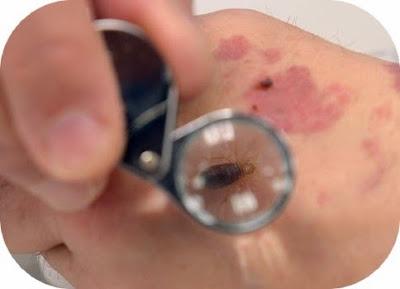
We used to see and feel them in old theater seats, train seats and in many other places. The very presence of them makes some feel sick – the poisons used to kill them also contribute in a big way in making people sick !! It is the common bedbugs (மூட்டைப்பூச்சி) – a species that prefer to feed on human blood.The name "bed bug" is derived from the insect's preferred habitat of houses and especially beds or other areas where people sleep. Bed bugs, though not strictly nocturnal, are mainly active at night and are capable of feeding unnoticed on their hosts. All insects in this family live by feeding exclusively on the blood of warm-blooded animals. They are known by variety of names such as wall louse, mahogany flat, crimson rambler, heavy dragoon, chinche and redcoat. They can live in any area of the home and can reside in tiny cracks in furniture as well as on textiles and upholstered furniture.
Some other search led to this interesting post in Vox.com ~ For 60 years after World War II, Americans thought they'd finally eradicated bedbugs once and for all. They were wrong. Bedbugs have been a horrible staple of American life since the Mayflower. In 1926, infestations in hotels and apartments were so common that experts couldn't recall a time when they weren't a problem. People absolutely hated being bitten in the night by these tenacious bloodsuckers hiding in mattresses and cracks in the wall, but the bugs were seemingly impossible to wipe out. Then, in 1939, a Swiss chemist named Paul Hermann Muller discovered the pesticide DDT, which proved staggeringly effective at killing insects. And for decades thereafter, DDT and other chemical pesticides helped keep America's homes and hotels bedbug-free. But it didn't last. Since 2000, a new strain of pesticide-resistant bedbugs has been popping up all around the nation — in 2009, there were10,000 reported complaints in New York City alone. Apartment dwellers were waking up with mysterious bites and rashes on their skin and finding peppery flakes around their mattresses (bedbug poop). People couldn’t rid themselves of bedbugs, no matter how often they did laundry or threw out their mattresses. Once the bugs invaded, it seemed, almost nothing can stop them. The bedbug invasion is a skin-crawling story recounted in Brooke Borel’s riveting new book,Infested: How the Bed Bug Infiltrated Our Bedroom and Took Over the World (the book was partially funded by the Alfred Sloan Foundation). Vox.com has this story in an interview with - Borel, a science journalist, on how bedbugs have made a comeback, their tenacity and whether US might ever get rid of them again. ________________________________________ Brooke Borel: Yeah, one thing that really struck me was the similarities throughout history. When the bedbug resurgence happened in the last 15 years, we had all these newspaper articles saying, "Oh my god, they’re in the movie theaters, they're in this place, in that place." But when I went back and read some of the historical material, that’s always been the case. When insectidal DDT was used, most insects had never experienced this type of poison before — and they were very vulnerable to it. There might have been other factors in knocking down bedbug numbers, too. Some experts point to different housekeeping practices that emerged after World War II — people were using vacuum cleaners more, and so on. That’s more anecdotal than anything else. BB: Some people still say the only reason we have bedbugs now is because we banned DDT [after concerns about its threat to wildlife]. But that’s just not true. We would’ve had this problem regardless of the ban. The bigger problem is that bedbugs were becoming resistant to DDT, and that was starting to happen way before the ban occurred. One hypothesis is that it started in Eastern Europe. There’s also an idea that resistant bedbugs came from somewhere in Africa because of the use of pyrethroid-impregnated mosquito nets. But the resistance is definitely a problem. Bedbugs have what’s called a knockdown resistance— it’s the same genetic mutation that gives them resistance to DDT. There are other factors, too. Some people aren’t allergic to them, so they might catch the problem only far later when it’s become a really bad infestation. Also, they can spread very easily in cities — because to get rid of them you have to work with other people sharing living space or sharing walls. That can be incredibly difficult. Bedbugs are especially difficult, because they live in our bedroom, and that’s one of the places we want to be especially careful when it comes to applying insecticides. So that’s part of the issue there. A lot of these bedbug research labs require too many bugs to be able to do research. One of the fascinating things I learned was that it took a long time for scientists to figure out how best to keep bedbugs alive in the lab, given that they’re so hard to kill in the wild. This interview has been edited and cut short without rhyme in my post ~ but yet would convey that ‘bedbug’ is still a nagging problem in US; however, I have not read about any ‘bed bug joke’ in recent Tamil magazines ~and does that mean, they are not around here ?? With regards – S. Sampathkumar 28th Apr. 2015.
News source : www.vox.com

